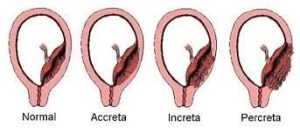 Refers to an abnormally deep attachment of the placenta into the myometrium.
Refers to an abnormally deep attachment of the placenta into the myometrium.
Patients are at great risk for hemorrhage during placental separation.
Treatment usually requires surgical intervention to stop hemorrhage and remove the placenta.
Affects 1 in 2500 pregnancies.
75-78% of cases the attachment to the myometrium does not penetrate through the entire thickness of the muscle.
Further penetration into the myometrium occurs in 17% of cases and is referred to as placenta increta.
If the placental penetration occurs through the myometrium and into the uterine serosa it is referred to as placenta percreta and account for 5-7% of cases of placenta accreta.
Placenta percreta is the worst type of placenta accreta and can even have placental attachment to surrounding bladder and rectum.
Diagnosis is very difficult before birth and only rarely recognized before delivery.
MRI and ultrasound studies may suggest the diagnosis but rarely confirm the diagnosis with any degree of certainty.
In some cases the second trimester alpha-fetoprotein levels may be elevated.
Occasionally associated with third trimester bleeding.
The diagnosis suggested if the placenta is not delivered by 30 minutes after delivery.
The placenta is attached so firmly to the uterine wall it cannot separate as it normally would and the uterus cannot contract enough to control bleeding after delivery.
Bleeding and the operations performed to control it, are the main causes of injury and death.
Blood transfusions are required in over half of the women.
A hysterectomy is almost always necessary.
The most significant risk to the baby is prematurity.
Almost two-thirds of babies born premature, usually between the 34th and 35th week of pregnancy.
Affects about 10% of placenta previa cases.
Increased incidence in scars of the uterus such as with Asherman’s syndrome, past D and C procedures, and Cesarean section.
May be associated with a thin decidua.
May be a higher incidence with female fetuses.
If diagnosed before delivery Cesarean section and hysterectomy can be performed.
Attempts to resect the placenta may be considered if preserving the uterus for future pregnancies is important.
